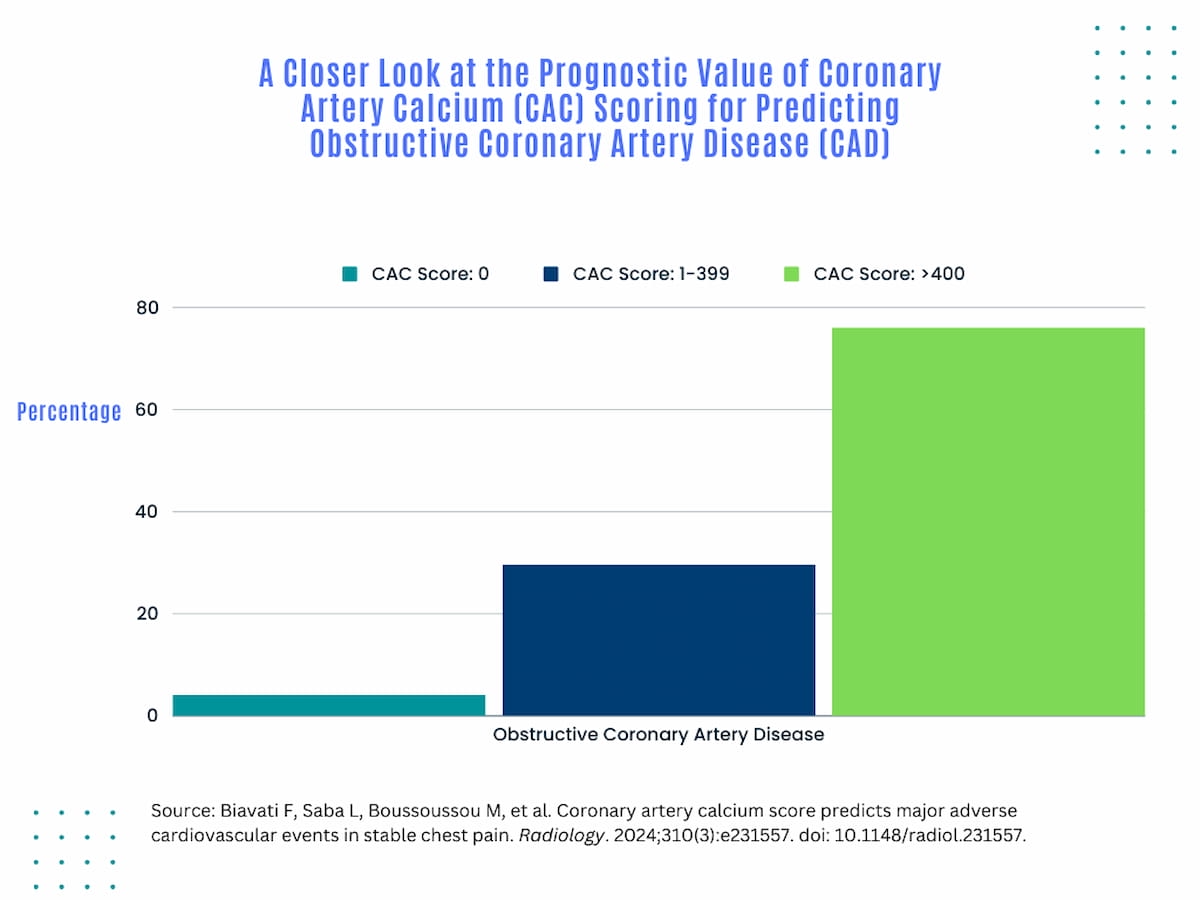Results from a prospective multinational trial reveal a strong correlation between computed tomography (CT)-derived calcium artery calcium (CAC) scores and major adverse cardiovascular events (MACEs).
For the prospective study, recently published in Radiology, researchers reviewed CAC data for 1,749 people (mean age of 60) with stable chest pain with a 3.5-year median follow-up period. The cohort was comprised of 755 people with a CAC score of 0, 743 participants with a CAC score between 1 and 399, and 251 people with a CAC score of 400 or higher, according to the study, which was a subgroup analysis from the Diagnostic Imaging Strategies for Patients with Stable Chest Pain and Intermediate Risk of Coronary Artery Disease (DISCHARGE) trial.
The researchers found that 4.1 percent of study participants with a CAC score of 0 (31 out of 755) had obstructive CAD findings at CT angiography in comparison to 76.1 percent of those with a CAC score of 400 or higher (191 out of 251). Median follow-up findings revealed that only 4 of 755 people with a CAC score of 0 had MACEs in contrast to 14 of 743 people with a CAC score of 1 to 399, and 17 of 251 participants with a CAC score of 400 or higher, according to the study authors. They pointed out that a CAC score of 400 or higher more than tripled the hazard ratio (HR) for MACE (.27 HR) in contrast to CAC scores of 0 (.08 HR).
“ … CAC scoring showed excellent performance in ruling out MACE in symptomatic individuals with stable chest pain and an intermediate pretest probability of CAD (coronary artery disease),” wrote study co-author Marc Dewey, M.D., a profess or and vice-chair of radiology at Charite Universitatsmedizin Berlin in Berlin, Germany, and colleagues.
The study authors also noted 32.2 percent and 11.6 percent increases in percutaneous coronary interventions (33.9 percent vs. 1.7 percent) and coronary artery bypass grafting procedures (12.4 percent vs. 0.8 percent), respectively, for those with CAC scoring of 400 or higher in comparison to participants with a CAC score of 0.
Noting a higher percentage of female participants in the cohort (57 percent) in comparison to previously related studies, the researchers found no statistically significant differences between women and men in either than CAC score 0 group or the CAC 400 or higher scoring group with respect to obstructive CAD, percutaneous coronary interventions, or coronary artery bypass grafting.
“By including a sizable number of female participants, the DISCHARGE trial helps to address sex bias and provide more robust and reliable data regarding risk assessment and decision-making for both symptomatic male and female patients,” added Dewey and colleagues.
Three Key Takeaways
- Strong correlation between CAC scores and cardiovascular events. The prospective multinational trial indicates a robust correlation between computed tomography (CT)-derived coronary artery calcium (CAC) scores and major adverse cardiovascular events (MACEs). The study found that higher CAC scores were associated with an increased risk of obstructive coronary artery disease (CAD) and MACEs over a median follow-up period of 3.5 years.
- CAC scoring as a prognostic tool in symptomatic individuals. The study highlights the performance of CAC scoring in ruling out MACEs in symptomatic individuals with stable chest pain and an intermediate pretest probability of CAD. Specifically, individuals with CAC scores of 400 or higher had a more than threefold higher hazard ratio for MACEs in contrast to study participants with a CAC score of 0.
- Limitations and considerations for clinical practice. While the study demonstrated that CAC scoring is a strong prognostic tool, the authors of an accompanying editorial emphasized the importance of considering additional factors, such as total plaque burden and plaque characteristics, in assessing patients for risks of atherosclerotic cardiovascular disease (ASCVD). Noting the detection of noncalcified plaque in over 25 percent of individuals with a CAC score of 0, the editorial authors cautioned against sole diagnostic reliance on CAC assessment. Additionally, the study's authors noted the importance of future research to evaluate CAC scoring in different patient groups and with longer-term follow-up assessments.
In an accompanying editorial, Kate Hanneman, M.D., MPH, and Gaurav Gulsin, MBChD, Ph.D., noted the study findings clearly demonstrate the viability of CAC scoring “as a strong prognostic tool regardless of symptoms.” However, they cautioned that CAC should be used adjunctively given increasing evidence about the roles of total plaque burden and plaque characteristics in assessing patients for risks of atherosclerotic cardiovascular disease (ASCVD).
“In the present study, noncalcified plaque was detected with coronary CT angiography in 26% of participants (198 of 755) with a CAC score of 0, highlighting a considerable added burden of (CAD) that would go undetected using CAC assessment alone and a potential missed opportunity for information that could be used to inform decisions on preventive therapy or lifestyle changes in this subgroup of patients,” emphasized Dr. Hanneman, an associate professor and vice chair of research at the University of Toronto, and Dr. Gulsin, a National Institute for Health and Care Research academic clinical lecturer in cardiology at the University of Leicester in the United Kingdom.
(Editor’s note: For related content, see “Study Says CT Scan is More Predictive than Genetic Risk Factors for Coronary Heart Disease Risk,” “AMA Issues New CPT Code for AI Estimates of CCTA-Based Fractional Flow Reserve” and “Five Takeaways from New Consensus Recommendations for CT Imaging and Reporting in Patients with CAD.”)
In regard to study limitations, the study authors said extrapolation of the study findings to broader populations may be limited given the study’s focus on people with stable chest pain. They emphasized that future studies are needed to assess the prognostic value of CAC scoring for those who have had prior revascularization or people with acute coronary syndrome. The researchers also suggested longer-term follow-up assessment of CAC score prognostication beyond the 3.5 year-period in this study as a focus of future research.


